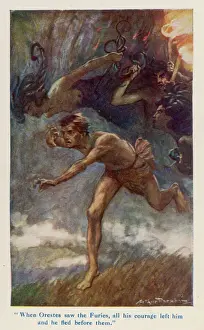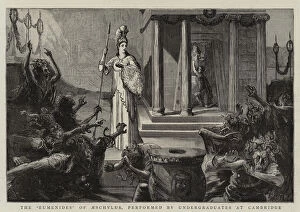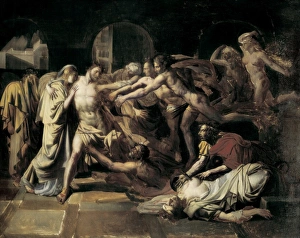Eumenides Collection
"Eumenides: The Divine Pursuit of Justice and Redemption" In the realm of Greek mythology, the tale of Orestes and the Eumenides unfolds as a captivating saga
All Professionally Made to Order for Quick Shipping
"Eumenides: The Divine Pursuit of Justice and Redemption" In the realm of Greek mythology, the tale of Orestes and the Eumenides unfolds as a captivating saga. Depicted in various artistic forms throughout history, this ancient narrative continues to captivate audiences with its themes of justice, vengeance, and ultimate redemption. One such portrayal is found in the 18th-century pen and ink drawing titled "The Furies Departing from Athena, Apollo, and Orestes. " This evocative artwork captures the moment when Orestes seeks solace from Athena and Apollo after committing matricide. As he stands at their mercy, one can sense his inner turmoil juxtaposed against their divine presence. Another representation comes in the form of an engraving depicting undergraduates at Cambridge performing Aeschylus' masterpiece "The Eumenides. " This image transports us back to a time when young scholars brought these timeless stories to life on stage – a testament to their enduring relevance even centuries later. A chromolithograph simply titled "Eumenides" further immerses us into this mythological world. Its vibrant colors breathe life into the three goddesses who personify vengeance but also serve as agents for retribution and restoration. Their fierce determination is palpable as they carry out their sacred duty. Moving beyond just visual artistry, we encounter sketches like "Design for Aeschylus: The Eumenides" created around 1919. Here we witness an artist's interpretation taking shape through pencil strokes and watercolor washes on paper – a glimpse into their creative process that brings forth new dimensions to this age-old tale. While exploring related artworks, we stumble upon depictions surrounding Orpheus' tragic demise. Giulio Romano's haunting piece portrays Orpheus torn apart by Maenads - wild female followers of Dionysus - emphasizing both his vulnerability and his connection to themes of fate and mortality.














